The Geochemistry of 1 ky Old Euxinic Sediments of the Western Black Sea
Abstract
1. Introduction
2. Materials and Methods
2.1. Samples
2.2. Analytical Techniques
3. Results
4. Discussion
5. Conclusions
Author Contributions
Funding
Acknowledgments
Conflicts of Interest
Abbreviations
| EF | Enrichment Factor |
| ENAA | Epithermal Neutron Activation Analysis |
| INAA | Instrumental Neutron Activation Analysis |
| NASC | North American Shale Composite |
| PAAS | Post-archaean Australian Average Shale |
| PC | Principal Component |
| PCA | Principal Component Analysis |
| PGAA | Prompt Gamma-ray Activation Analysis |
| UCC | Upper Continental Crust |
| XRD | X-ray Diffraction |
Appendix A
| Element | c | u | UCC | NASC | Element | c | u | UCC | NASC | ||
|---|---|---|---|---|---|---|---|---|---|---|---|
| SiO | 42.07 | 2.56 | 3.0% | 66.62 | 64.8 | Zr | 189 | 27 | 3.8% | 193 | 200 |
| TiO | 0.64 | 0.07 | 6.2% | 0.64 | 0.7 | Mo | 42.5 | 5 | 3.3% | 1.1 | n |
| AlO | 12.87 | 1.56 | 2.5% | 15.4 | 16.9 | Sn | 2.9 | 1.4 | 6.7% | 2.1 | n |
| FeO | 5.11 | 0.5 | 3.8% | 5.04 | 5.66 | Sb | 2.7 | 1.4 | 8.7% | 0.4 | n |
| MnO | 0.07 | 0.01 | 4.9% | 0.1 | 0.06 | I | 94 | 24 | 8.5% | 1.4 | n |
| MgO | 2.2 | 0.59 | 5.2% | 2.48 | 2.86 | Cs | 5.5 | 0.7 | 6.3% | 4.9 | n |
| CaO | 28.41 | 4.41 | 7.0% | 3.59 | 3.63 | Ba | 488 | 127 | 8.8% | 624 | 636 |
| NaO | 4.24 | 0.66 | 7.5% | 3.27 | 1.14 | La | 29 | 4 | 8.5% | 31 | 31 |
| KO | 2.56 | 0.42 | 4.5% | 2.8 | 3.97 | Ce | 63 | 8 | 8.3% | 63 | 67 |
| Cl | 4030 | 620 | 3.5% | 370 | n | Nd | 22.7 | 6.6 | 7.5% | 27 | 27 |
| Sc | 11 | 1.2 | 6.9% | 14 | 15 | Sm | 3.8 | 0.95 | 5.8% | 4.7 | 5.6 |
| V | 110 | 19 | 8.8% | 97 | 130 | Eu | 0.8 | 0.3 | 8.8% | 1 | 1.2 |
| Cr | 62 | 11.2 | 7.7% | 92 | 125 | Gd | 4.1 | 0.8 | 8.9% | 4 | 5.2 |
| Co | 16 | 2 | 6.8% | 17.3 | 26 | Tb | 0.7 | 0.1 | 8.3% | 0.7 | 0.05 |
| Ni | 53 | 8 | 8.9% | 47 | 58 | Yb | 1.8 | 0.2 | 8.2% | 2 | 3.1 |
| Zn | 82 | 19 | 5.5% | 67 | n | Hf | 5.1 | 0.6 | 8.5% | 5.3 | 6.3 |
| As | 11.1 | 2 | 7.9% | 4.8 | n | Ta | 0.7 | 0.1 | 7.6% | 0.9 | 1.1 |
| Se | 5.2 | 3.3 | 6.9% | 0.09 | n | W | 5 | 3.1 | 7.3% | 1.9 | n |
| Br | 87 | 20.8 | 8.9% | 1.6 | n | Th | 9.8 | 1.2 | 7.1% | 10.5 | 12.5 |
| Rb | 84 | 11.1 | 8.2% | 84 | 125 | U | 9.9 | 1.2 | 8.3% | 2.7 | 2.7 |
| Sr | 710 | 180 | 5.5% | 320 | 142 |
| Depth (mm) | Clay | Carb | Qtz | Gl | Gyp | Depth (mm) | Clay | Carb | Qtz | Gl | Gyp |
|---|---|---|---|---|---|---|---|---|---|---|---|
| 0–5 | 34 | 65 | - | - | - | 115–120 * | 35 | 60 | 3 | - | 1 |
| 5–10 | 49 | 50 | 1 | - | - | 120–125 | 44 | 55 | 1 | - | - |
| 10–15 | 43 | 55 | 1 | - | 1 | 125–130 | 60 | 40 | <1 | - | - |
| 15–20 | 39 | 90 | 1 | - | - | 130–135 * | 35 | 60 | <5 | - | - |
| 20–25 | 50 | 50 | - | - | - | 135–140 | 50 | ∼50 | <1 | - | - |
| 25–30 | 35 | 65 | - | - | - | 140–145 | 40 | 55 | 4 | - | 1 |
| 30–35 | 56 | 40 | <4 | - | - | 145–150 * | 47 | 50 | 1 | - | 1 |
| 35–40 | 48 | 50 | 2 | - | - | 150–160 | 38 | 60 | ∼2 | - | - |
| 40–45 | 32 | 60 | 8 | - | - | 160–170 | 48 | 50 | 1 | - | ∼1 |
| 45–50 | 58 | 40 | 1 | - | <1 | 170–180 | 47 | 50 | 2 | - | <1 |
| 50–55 | 58 | 40 | 1 | - | <1 | 180–190 | 45 | ∼50 | <5 | <1 | - |
| 55–60 | 58 | 40 | 1 | 1 | - | 190–200 | 35 | ∼60 | <5 | <1 | - |
| 60–65 | 25 | 70 | 4 | 0.5 | 0.5 | 200–210 | 49 | ∼50 | <1 | - | - |
| 65–70 | 48 | 50 | 2 | - | - | 210–220 | 49 | ∼50 | <1 | - | - |
| 70–75 | 45 | ∼55 | <0.5 | - | - | 220–230 | 60 | ∼40 | <0.5 | - | - |
| 75–80 | 17 | 80 | 2 | - | <0.5 | 230–240 | 70 | ∼30 | <1 | - | - |
| 80–85 | 23 | 75 | <1 | - | 1 | 240–250 | 60 | ∼40 | <1 | - | - |
| 85–90 | 23 | 75 | 0.5 | - | 1.5 | 250–300 | 20 | 75 | 5 | - | - |
| 90–95 | 16 | 80 | 3 | <1 | 300–350 | 50 | ∼50 | <1 | - | - | |
| 95–100 | 8 | 90 | 1 | 1 | - | 350–400 | ∼60 | ∼40 | - | - | - |
| 100–105 | 45 | 90 | 1 | - | - | 400–450 | 53 | 45 | 2 | - | - |
| 105–110 | 30 | 70 | <0.5 | - | - | 450–500 | 54 | 45 | 1 | - | - |
| 110–115 | 35 | 63 | ∼1 | - | 1 | - | - | - | - | - | - |
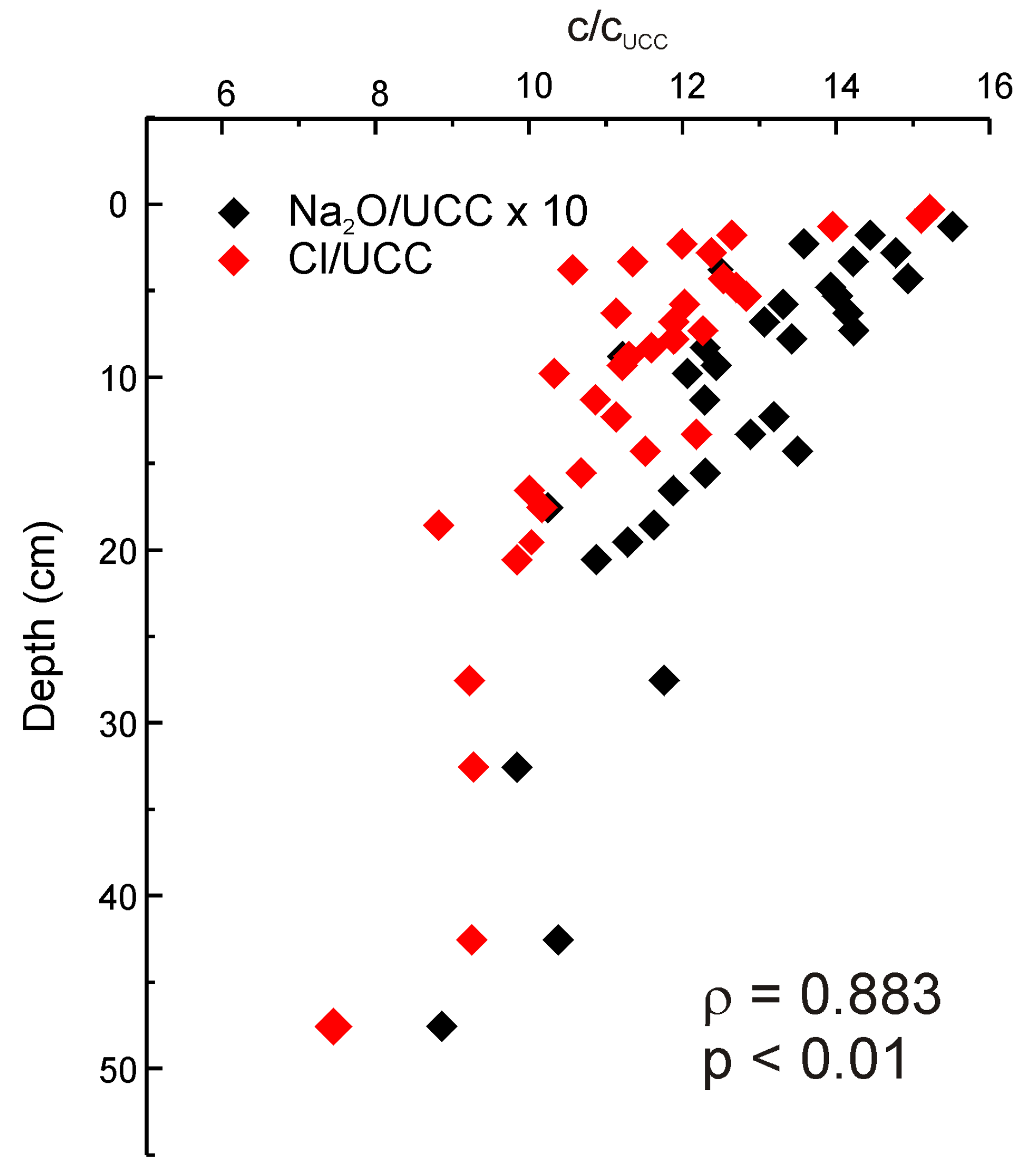
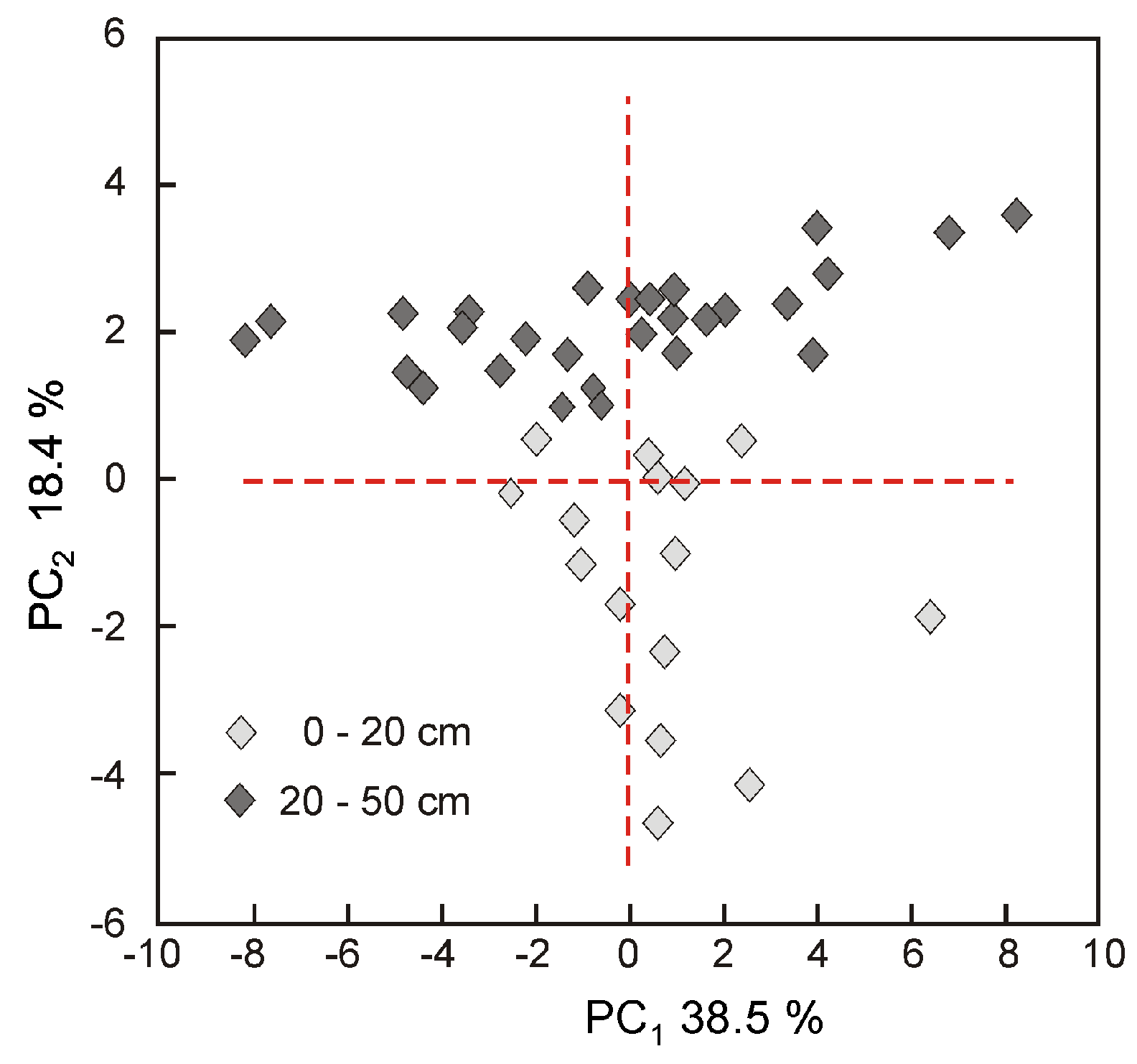
| Element | PC1 | PC2 | Element | PC1 | PC2 | Element | PC1 | B |
|---|---|---|---|---|---|---|---|---|
| SiO | 0.231 | −0.442 | Ni | 0.104 | 0.005 | La | 0.538 | −0.452 |
| TiO | 0.086 | −0.225 | Zn | 0.828 | 0.117 | Ce | −0.123 | −0.239 |
| AlO | −0.118 | −0.589 | As | 0.706 | −0.214 | Nd | −0.383 | 0.243 |
| FeO | −0.017 | −0.505 | Se | −0.561 | 0.155 | Sm | 0.328 | −0.616 |
| MnO | −0.365 | −0.226 | Br | 0.579 | 0.022 | Eu | 0.461 | −0.315 |
| MgO | 0.040 | −0.006 | Rb | 0.059 | −0.391 | Gd | 0.074 | −0.474 |
| CaO | −0.275 | 0.551 | Sr | −0.448 | 0.881 | Tb | 0.31 | −0.479 |
| NaO | 0.924 | 0.048 | Zr | 0.207 | −0.040 | Yb | 0.087 | −0.140 |
| KO | 0.427 | −0.437 | Mo | 0.334 | −0.021 | Hf | 0.375 | −0.364 |
| Cl | 0.999 | 0.036 | Sn | 0.464 | 0.304 | Ta | 0.207 | −0.419 |
| Sc | 0.110 | −0.426 | Sb | 0.833 | 0.180 | W | 0.369 | 0.140 |
| V | 0.019 | −0.070 | I | 0.247 | 0.427 | Th | 0.046 | −0.282 |
| Cr | −0.321 | 0.186 | Cs | 0.075 | −0.563 | U | −0.27 | 0.511 |
| Co | 0.171 | −0.222 | Ba | 0.345 | 0.356 |
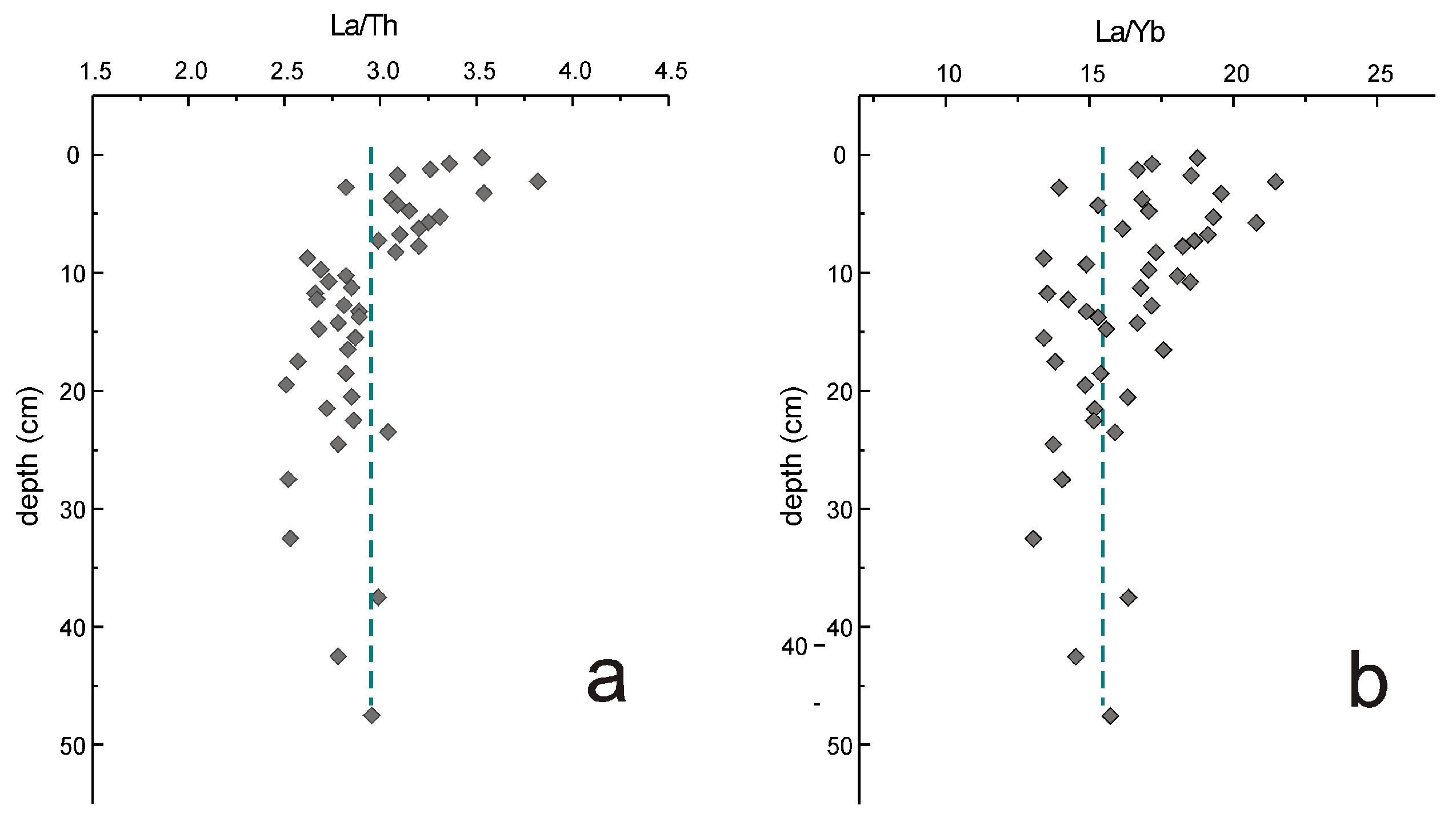
References
- European Comision. The Black Sea: Facts and Figures, Environment and Enlargement. Available online: http://ec.europa.eu/environment/enlarg/blackseafactsfigures_en.htm (accessed on 18 August 2019).
- Murray, J.W.; Jannasch, H.W.; Honjo, S.; Anderson, R.F.; Reeburgh, W.S.; Top, Z.; Friederich, G.E.; Codispoti, L.A.; Izdar, E. Unexpected changes in the oxic/anoxic interface in the Black Sea. Nature 1989, 338, 411–413. [Google Scholar] [CrossRef]
- Özsoy, E.; Unluata, U. Oceanography of the Black Sea: A review of some recent results. Earth Sci. Rev. 1997, 42, 231–272. [Google Scholar] [CrossRef]
- Vespremeanu, E.; Golumbeanu, M. Catchment Area of the Black Sea. In The Black Sea: Physical, Environmental and Historical Perspectives; Vespremeanu, E., Golumbeanu, M., Eds.; Springer Geography: Cham, Switzerland, 2018; pp. 15–25. [Google Scholar]
- Panin, N.; Jipa, D.C.; Gomoiu, M.-T.; Secrieru, D. Importance of Sedimentary Processes in Environmental Changes: Lower River Danube–Danube Delta–Western Black Sea System. In Environmental Degradation of the Black Sea: Challenges and Remedies; Besiktepe, S.T., Ünlüata, Ü., Içel, E., Bologa, A.S., Eds.; Kluwer: Dordrecht, The Netherlands, 1999; pp. 23–41. [Google Scholar]
- Panian, N.; Jipa, D. Danube River sediments input and interaction with the Northwest Black Sea. Estuar. Coast. Shelf Sci. 2002, 54, 551–562. [Google Scholar] [CrossRef]
- Crusius, J.; Calvert, S.; Pedersen, T.; Sage, D. Rhenium and molybdenum enrichments in sediments as indicators of oxic, suboxic and sulfidic conditions of deposition. Earth Planet. Sci. Lett. 1996, 145, 65–78. [Google Scholar] [CrossRef]
- Crusius, J.; Thomson, J. Mobility of authigenic rhenium, silver, and selenium during postdepositional oxidation in marine sediments. Geochim. Cosmochim. Acta 2003, 67, 265–273. [Google Scholar] [CrossRef]
- Morford, J.L.; Emerson, S. The geochemistry of redox sensitive trace metals in sediments. Geochim. Cosmochim. Acta 1999, 63, 1735–1750. [Google Scholar] [CrossRef]
- Lyons, T.W.; Severmann, S. A critical look at iron paleoredox proxies: New insights from modern euxinic marine basins. Geochim. Cosmochim. Acta 2006, 70, 5698–5722. [Google Scholar] [CrossRef]
- Boothman, W.S.; Coiro, L.L. Laboratory determination of molybdenum accumulation rates as a measure of hypoxic conditions. Estuaries Coasts 2009, 32, 642–653. [Google Scholar] [CrossRef]
- Baturin, G.N. Geochemistry of Sapropel in the Black Sea. Geochem. Int. 2011, 49, 531–535. [Google Scholar] [CrossRef]
- Eckert, S.; Brumsack, H.-J.; Severmann, S.; Schnetger, B.; März, C.; Frröllje, H. Establishment of euxinic conditions in the Holocene Black Sea. Geology 2013, 41, 431–434. [Google Scholar] [CrossRef]
- Piper, D.Z. Rare earth elements in the sedimentary cycle: A summary. Chem. Geol. 1974, 14, 285–304. [Google Scholar] [CrossRef]
- McLennan, S.M.; Hemming, S.; McDaniel, K.; Hanson, G.L. Geochemical Approaches to Sedimentation, Provenance, and Tectonics. In Processes Controlling the Composition of Clastic Sediments; Johnsson, M.J., Basu, A., Eds.; Geological Society of America Special Paper: Boulder, CO, USA, 1993; Volume 284, pp. 21–40. [Google Scholar]
- Floyd, P.A.; Winchester, J.A.; Park, R.G. Geochemistry and tectonic setting of Lewisian clastic metasediments from the Early Proterozoic Loch Maree Group of Gairloch, NW Scotland. Precambrian Res. 1989, 45, 203–214. [Google Scholar] [CrossRef]
- Owens, P.N.; Blake, W.H.; Gaspar, L.; Gateuille, D. Fingerprinting and tracing the sources of soils and sediments: Earth and ocean science, geoarchaeological, forensic, and human health applications. Earth Sci. Rev. 2016, 162, 1–23. [Google Scholar] [CrossRef]
- Florea, N.; Cristache, C.; Oaie, G.; Duliu, O.G. Concordant 137Cs and 210Pb ages of Black Sea anoxic unconsolidated sediments. Geochronometria 2011, 38, 101–106. [Google Scholar] [CrossRef]
- Oaie, G.; Florescu, S. Mare Nigrum—The First Romanian Multidisciplinary Research Vessel in Romania. GeoEcoMarina 2003–2004, 9–10. Available online: http://www.geoecomar.ro/website/publicatii/Nr.9-10-2004/22.pdf (accessed on 16 May 2019).
- Duliu, O.G. Major and Trace Elements in Black Sea Euxinic Sediments. Mendeley Data 2019, v1. Available online: http://dx.doi.org/10.17632/d5f8c9gtv7.1 (accessed on 4 September 2019).
- Hussein, E.M.A. Handbook on Radiation Probing, Gauging, Imaging and Analysis; Kluwer: New York, NY, USA, 2004. [Google Scholar]
- Frontasyeva, M.V. Neutron activation analysis in the life sciences. Phys. Part. Nucl. 2011, 42, 332–378. [Google Scholar] [CrossRef]
- Alfassi, B. Epithermal neutron activation analysis. J. Radioanal. Nucl. Chem. 1985, 90, 151–165. [Google Scholar] [CrossRef]
- Molnár, G.L. (Ed.) Handbook of Prompt Gamma Activation Analysis with Neutron Beams; Springer, Kluwer Acadernic Publishers: Dordrecht, The Netherlands, 2004. [Google Scholar]
- Cristache, C.; Gméling, K.; Culicov, O.; Frontasyeva, M.V.; Toma, M.; Duliu, O.G. An ENAA and PGAA comparative study of anoxic Black Sea sediments. J. Radioanal. Nucl. Chem. 2009, 279, 7–12. [Google Scholar] [CrossRef]
- Zinicovscaia, I.; Duliu, O.G.; Culicov, O.-A.; Frontasyeva, M.V.; Sturza, R. Major and trace elements distribution in Moldavian soils. Rom. Rep. Phys. 2018, 70, 701. [Google Scholar]
- Crystallography Open Database. 2019. Available online: http://www.crystallography.net/ (accessed on 1 February 2019).
- Calvert, S.E.; Pedersen, T.F. Geochemistry of recent oxic and anoxic marine sediments: Implications for the geological record. Mar. Geol. 1993, 113, 67–88. [Google Scholar] [CrossRef]
- Ross, D.A.; Degens, E.T. Recent Sediments of the Black Sea. In The Black Sea—Geology, Chemistry and Biology; Degens, E.T., Ross, D.A., Eds.; American Association of Petroleum Geologists: Tulsa, OK, USA, 1974; Volume 20, pp. 183–199. [Google Scholar]
- Rudnick, R.L.; Gao, S. Composition of the Continental Crust. In Treatise on Geochemistry; Holland, H.D., Turekian, K.K., Eds.; Elsevier-Pergamon: Oxford, UK; London, UK, 2003; Volume 3, pp. 1–64. [Google Scholar]
- Calvert, S.E.; Karlin, R.E. Organic carbon accumulation in the Holocene sapropel of the Black Sea. Geology 1988, 26, 107–110. [Google Scholar] [CrossRef]
- Gromet, L.P.; Haskin, L.A.; Korotev, R.L.; Dymek, R.F. The “North American shale composite”: Its compilation, major and trace element characteristics. Geochim. Cosmochim. Acta 1984, 48, 2469–2482. [Google Scholar] [CrossRef]
- Little, S.H.; Vance, D.; Lyons, T.W.; McManus, J. Controls on trace metal authigenic enrichment in reducing sediments: Insights from modern oxygen-deficient settings. Am. J. Sci. 2015, 315, 77–119. [Google Scholar] [CrossRef]
- Scholz, F.; Severmann, S.; McManus, J.; Hensen, C. Beyond the Black Sea paradigm: The sedimentary fingerprint of an open-marine iron shuttle. Geochim. Cosmochim. Acta 2014, 127, 368–380. [Google Scholar] [CrossRef]
- Anderson, T.F.; Raiswell, R. Sources and mechanisms for the enrichment of highly reactive iron in euxinic Black Sea sediments. Am. J. Sci. 2004, 304, 203–233. [Google Scholar] [CrossRef]
- Taylor., S.; McLennan, S.M.; Taylor., S.; McLennan, S.M. The Continental Crust: Its Composition and Evolution; Blackwell: Oxford, UK, 1991. [Google Scholar]
- Duliu, O.G.; Cristache, C.; Oaie, G.; Culicov, O.A.; Frontasyeva, M.V.; Toma, M. ENAA Studies of pollution in anoxic Black Sea sediments. Mar. Pollut. Bull. 2009, 58, 827–831. [Google Scholar] [CrossRef]
- McNeal, J.M.; Feder, G.L.; Wiber, W.G.; Deverel, S.J. Environmental concern related to selenium in western United States. In Proceedings of the U.S. Geological Survey Workshop on Environmental Geochemistry; Doe, B.R., Ed.; USGS: Denver, CO, USA, 1990. [Google Scholar]
- Velinsky, D.J.; Cutter, G.A. Geochemistry of selenium in a coastal salt marsh. Geochim. Cosmochim. Acta 1991, 55, 179–191. [Google Scholar] [CrossRef]
- McDonough, W.F.; Sun, S.S. The Composition of the Earth. Chem. Geol. 1995, 120, 223–253. [Google Scholar] [CrossRef]
- McLennan, S.M. Rare Earth Elements in Sedimentary Rocks: Influence of Provenance and Sedimentary Processes. In Review in Mineralogy; Lipin, B.R., McKay, G.A., Eds.; Mineralogical Society of America: Washington, DC, USA, 1989; Volume 21, pp. 147–167. [Google Scholar]
- Tugulan, L.; Duliu, O.G.; Bojar, A.-V.; Dumitras, D.; Zinicovscaia, I.; Culicov, O.A.; Frontasyeva, M.V. On the geochemistry of the Late Quaternary loess deposits of Dobrogea (Romania). Quat. Int. 2016, 399, 100–110. [Google Scholar] [CrossRef]
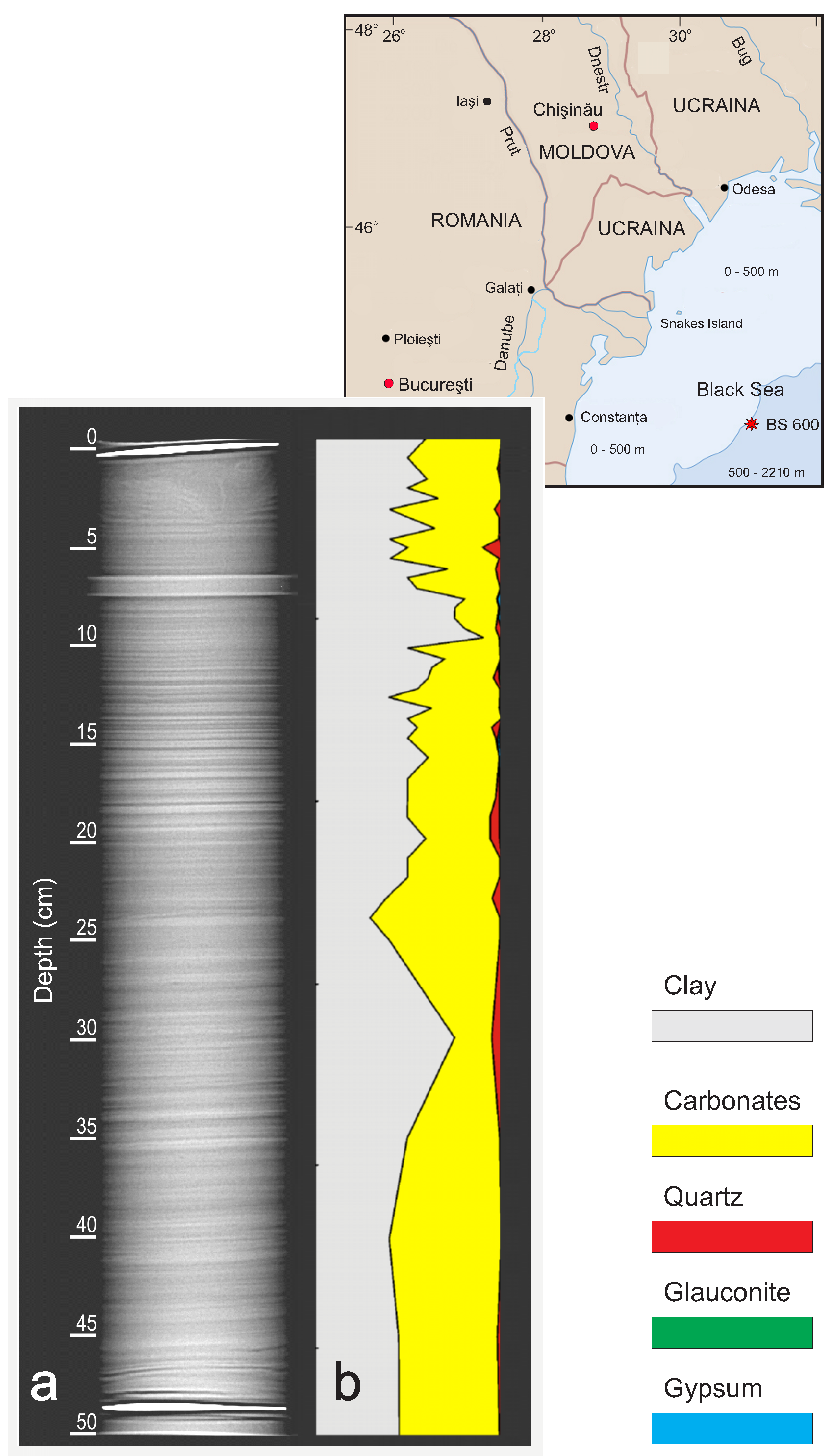
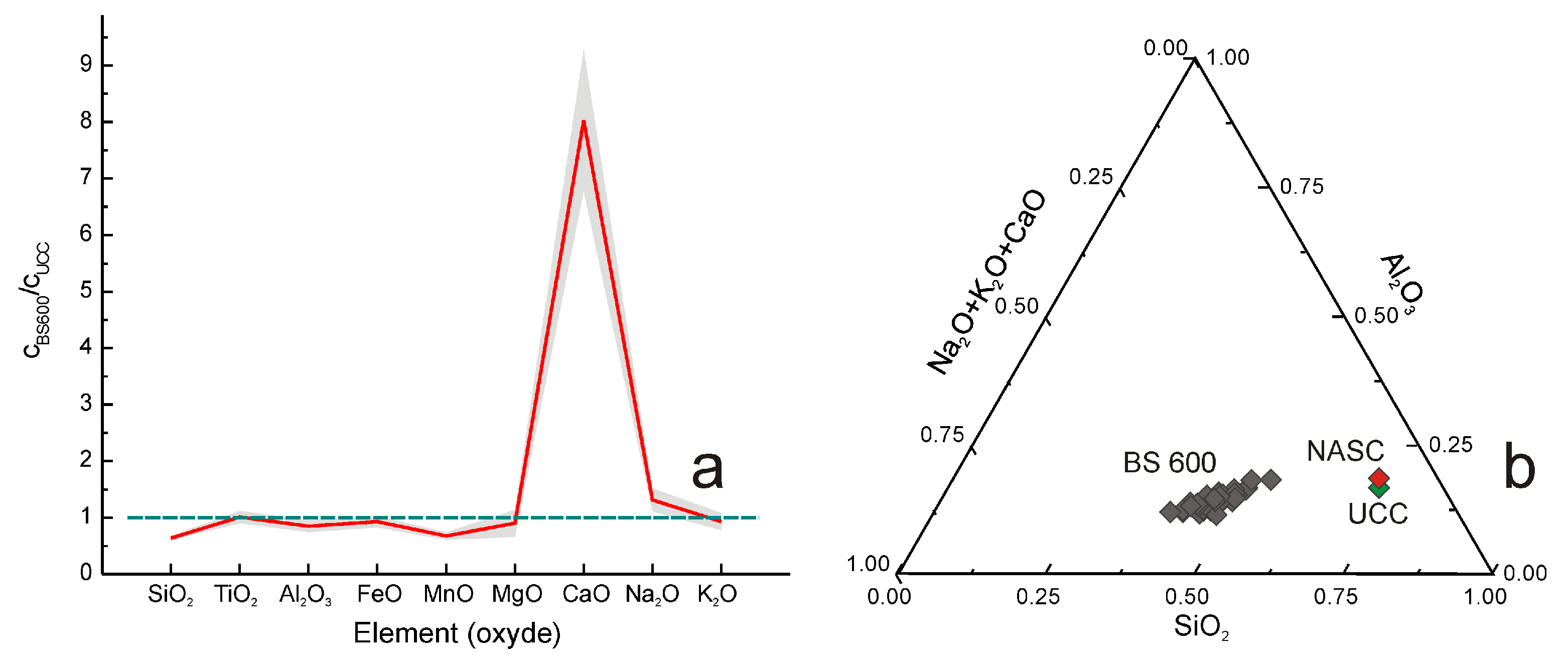
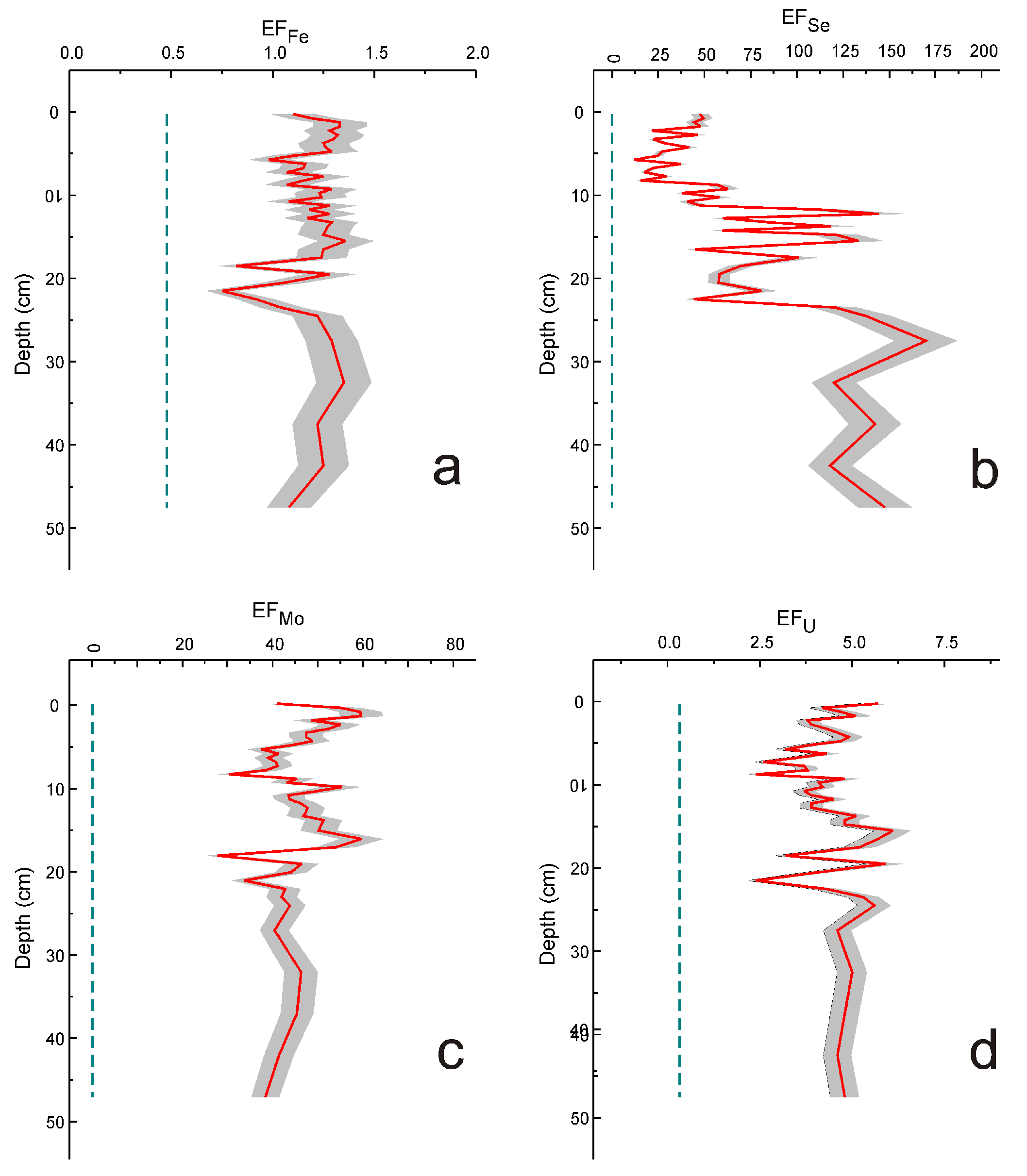

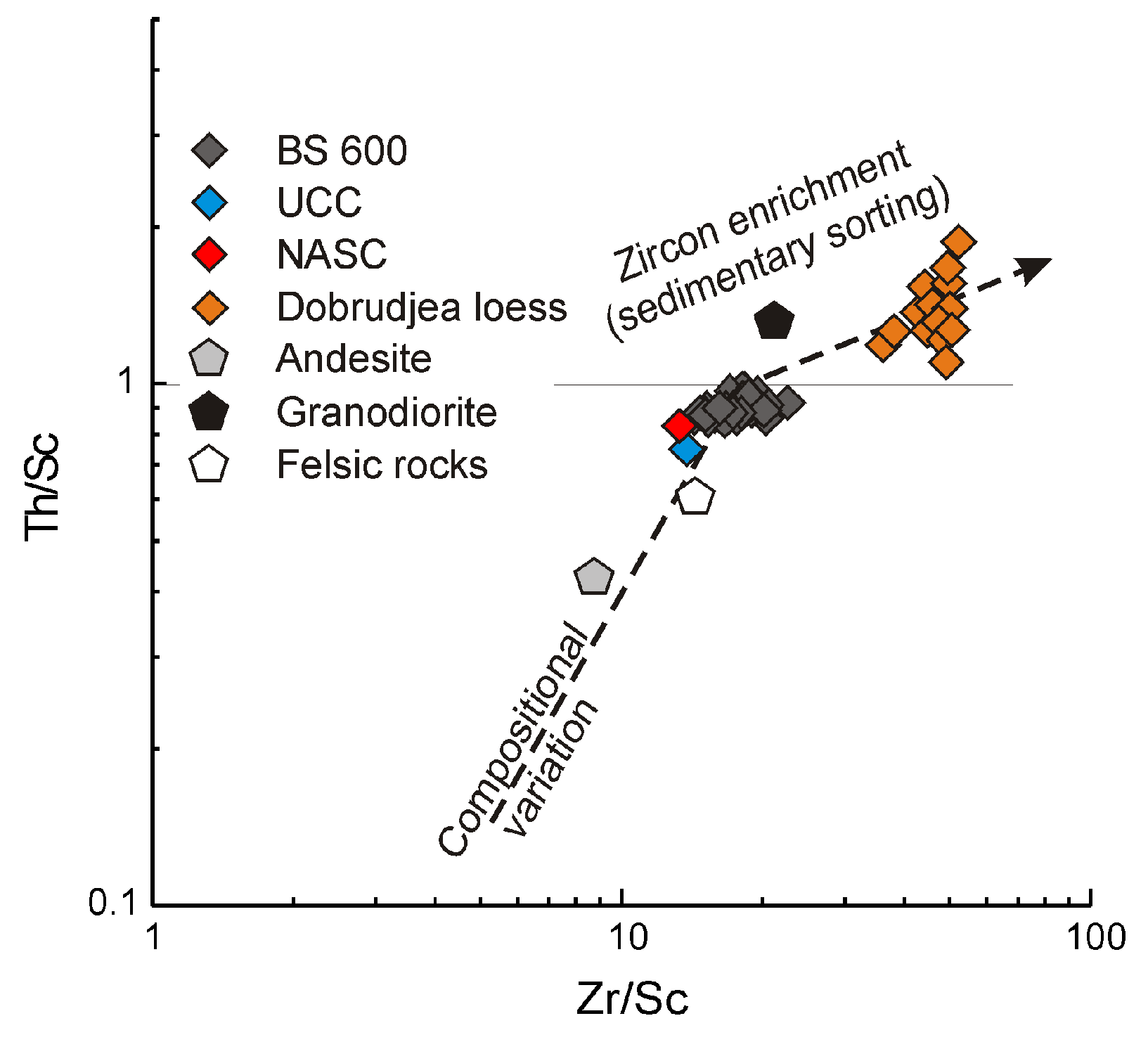
| SiO | TiO | AlO | FeO | MnO | MgO | CaO | NaO | KO | |
|---|---|---|---|---|---|---|---|---|---|
| TiO | 0.816 | ||||||||
| AlO | 0.429 | 0.346 | |||||||
| FeO | 0.572 | 0.503 | 0.799 | ||||||
| MnO | −0.133 | −0.093 | 0.555 | 0.378 | |||||
| MgO | −0.142 | −0.093 | −0.368 | −0.264 | −0.231 | ||||
| CaO | −0.839 | −0.638 | −0.636 | −0.783 | −0.027 | −0.045 | |||
| NaO | 0.212 | 0.167 | 0.125 | 0.206 | −0.283 | 0.022 | −0.429 | ||
| KO | 0.520 | 0.363 | 0.311 | 0.511 | −0.078 | −0.046 | −0.704 | 0.564 | |
| Cl | 0.211 | 0.149 | −0.026 | 0.186 | −0.149 | 0.036 | −0.438 | 0.889 | 0.432 |
| Element | FF | Literature Data | Element | FF | Literature Data | ||
|---|---|---|---|---|---|---|---|
| Fe | 0.75–1.36 | 0.93–1.28 euxinic margin | [10] | Mo | 28–60 | 80–376 euxinic stations 9 and 14 | [33] |
| 1.84–2.78 euxinic basin | |||||||
| 1.2–1.7 euxinic stations 9 and 14 | [33] | ||||||
| Se | 12–170 | <59 clayed ooze | [12] | U | 2.4–6.1 | 1.5 clayed ooze | [12] |
© 2019 by the authors. Licensee MDPI, Basel, Switzerland. This article is an open access article distributed under the terms and conditions of the Creative Commons Attribution (CC BY) license (http://creativecommons.org/licenses/by/4.0/).
Share and Cite
Duliu, O.G.; Cristache, C.I.; Bojar, A.-V.; Oaie, G.; Culicov, O.-A.; Frontasyeva, M.V.; Constantinescu, E. The Geochemistry of 1 ky Old Euxinic Sediments of the Western Black Sea. Geosciences 2019, 9, 455. https://doi.org/10.3390/geosciences9110455
Duliu OG, Cristache CI, Bojar A-V, Oaie G, Culicov O-A, Frontasyeva MV, Constantinescu E. The Geochemistry of 1 ky Old Euxinic Sediments of the Western Black Sea. Geosciences. 2019; 9(11):455. https://doi.org/10.3390/geosciences9110455
Chicago/Turabian StyleDuliu, Octavian G., Carmen I. Cristache, Ana-Voica Bojar, Gheorghe Oaie, Otilia-Ana Culicov, Marina V. Frontasyeva, and Emil Constantinescu. 2019. "The Geochemistry of 1 ky Old Euxinic Sediments of the Western Black Sea" Geosciences 9, no. 11: 455. https://doi.org/10.3390/geosciences9110455
APA StyleDuliu, O. G., Cristache, C. I., Bojar, A.-V., Oaie, G., Culicov, O.-A., Frontasyeva, M. V., & Constantinescu, E. (2019). The Geochemistry of 1 ky Old Euxinic Sediments of the Western Black Sea. Geosciences, 9(11), 455. https://doi.org/10.3390/geosciences9110455







